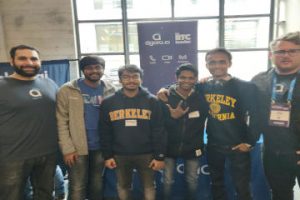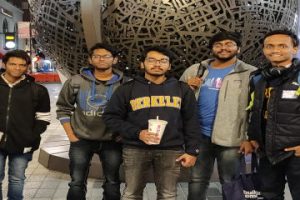SRM AP TEAM WIN TOP PRIZE AT DEVELOPER WEEK HACKATHON, SAN FRANCISCO
|
|
Koushik Bhargav Muthe, CSE and his team from Next Tech Lab – Saptarshi Mazumder, CSE, Rajarshi Mazumder, CSE, Agniswar Paul, ECE, Souradeep Das, SRM KTR, CSE, participated in the Developer Week Hackathon (one of the world’s largest challenge driven hackathons) and won the top prize with an award of $1,000 from Agoraio. The team developed a Blockchain based game that incentivises people to buy products and was selected as the best hack by the Agoraio panel. “We built an Ethereum based card trading game for shoppers that helps sellers win over more customers. We did this by incorporating the Agoraio’s chatting platform into our game.” says Koushik Bhargav.
AND ANOTHER ONE! THE BEST BLOCKCHAIN UTILITY HACK
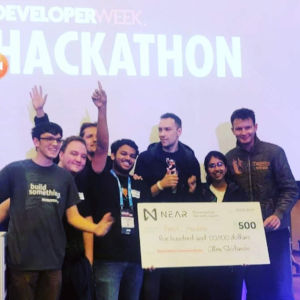
Miran, Niladri, and Sejal of Next Tech Lab from KTR – A Facebook developer and an entrepreneur, were among the top 5 teams at the Hackathon with 150+ teams and took the first prize for the “Best Blockchain Utility Hack” with a bounty of $500 from Near Protocol. The product will be shown in all developer week magazines. The team made a blockchain based contract system for making corporate or social contracts whereby both parties receive an email to accept or reject. Once both parties accept, an entry on the blockchain is made and the contract can be recovered anytime.
EARLIER IN DENVER

Koushik Bhargav CSE SRM AP and head of Satoshi lab at Next Tech lab, Sauradeep Das, CSE SRM KTR and Agniswar Paul, CSE SRM AP (all three presently in UC Berkeley for the 2019 semester abroad program) taking in the technological wonders at ETH Denver, Colorado, the world’s biggest Ethereum hackathon and conference, Feb.14-17. “It was one the best conferences I have attended, got to meet amazing people working on Blockchain technology from all over the world,” says Koushik. It was great because Satoshi lab focuses completely on Blockchain technology.” Koushik and his colleagues including Miran Junaidi shared ideas with developers, Blockchain startups, mentors and developing hacks. “Many more amazing events lined up for our semester in University of California, Berkeley.”
- Published in News
SRM AP’s intra-faculty Data Science course now in collaboration with UC Berkeley
This year SRM AP introduces Data Science for all students in the School of Liberal Arts and Basic Sciences (SLABS). Supported by intellectual capital of colleagues at the University of California- Berkeley, SRM AP’s Data Science course comprises lectures and labs that encourage discussion as students get comfortable in simple programming using Python.
“Recognizing that data science is an essential building block for critical applications of today and the future we are offering it as a foundation course for all SLABS students”, says SLABS Associate Dean, Dr. Shailender Swaminathan.
- Published in News
‘IPS based attendance system’ wins top prize at Ennovab’s business plan competition
Pitchathon 2k19 – a 24-hour entrepreneurial journey with a big result!
Ennovab, SRM AP’s entrepreneurial innovation lab launched the first 24-hour business plan competition that went from founders speed dating (complete strangers in insightful conversations) to rigorous brainstorming, to five groups of fifty students with common problems running market research, prototyping, punching out financial models – to the final pitch.
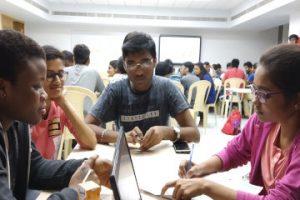 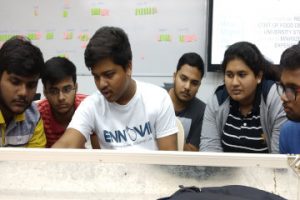 |
An IPS based Attendance System (an idea proposed by five first year students Prannoy Tuggiti, Manoj Manike, Moin Syed, Prabhu Avula, and Anvesh Reddyh) was awarded the first prize by a distinguished panel of judges (T. Ragunathan, Head of Computer Science and Engineering with 25 years in database systems; Dr. Srabani Basu, professor at Career Development Centre and former senior corporate trainer at Addeco India; and Dr. Marc Howard Rich, professor of English and Journalism, and former lecturer at Christopher Newport University)
The IPS based attendance system is a mobile application that enables students to mark attendance – one student per app. Of course, it works only if their location (determined by IPS, the Indoor Positioning System) is detected to be inside the stipulated class!
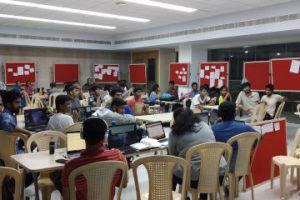 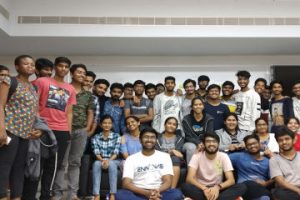 |
The first runner up team (Jaideep Cherukuri, Yash tripathi, Bhavana Yedlapalli, Krishna, Abhishree Sai) proposed a real-time ETA system for autos so SRMites located in the middle of nowhere can make quick getaways!
While the 2nd runner up team of Rahul Gupta, Ruthwik Reddy, Dileep Patted, Arumilli Nikitha and Poorna Sai proposed a Smart ID card that can be used instead of paper coupons in places like the canteen and library.
To join future events follow @ennovab on Instagram.
- Published in News
SRM AP NOW A FOUNDING MEMBER OF THE COLLEGE BOARD’S INDIA GLOBAL HIGHER EDUCATION ALLIANCE
At the recent College Board’s ‘India Global Higher Education Alliance’ symposium in Bangalore, SRM AP Director, Admissions Rupesh Bisht received the membership plaque from Linda Liu, Vice President, International, The College Board – the US based institution behind the SAT.

With this membership SRM AP joins a distinguished group of institutions in India and abroad (including Ashoka University, Columbia University and University of Cambridge) in adopting the SAT as a benchmark in the admissions processes. “As a founding member of the India Global Higher Education Alliance we will collectively shape the agenda of inclusivity and access to high quality higher education in India, says Rupesh Bisht. “SAT scores have proven predictive validity of student performance and we intend to use these as an admissions criterion in addition to our SRMJEEE test.”
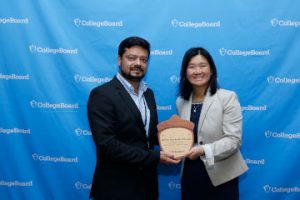  |
At this event, leaders from the Alliance’s member universities gathered with prominent experts from the World Bank, Brookings India, Manipal Education Group and the Consortium for Higher Education Research in Asia (CHERA) to foster collaboration and the sharing of global best practices to advance access and excellence in higher education.
Some of the initiatives discussed: providing high quality education at the scale needed to meet India’s demands, increasing autonomy at leading universities, connecting university researchers to India’s national laboratories, the need to shift away from lecture-based classes to more project-based coursework and a call for institutions to put students at the top of their priority list.
https://international.collegeboard.org/india-global-alliance
- Published in News


